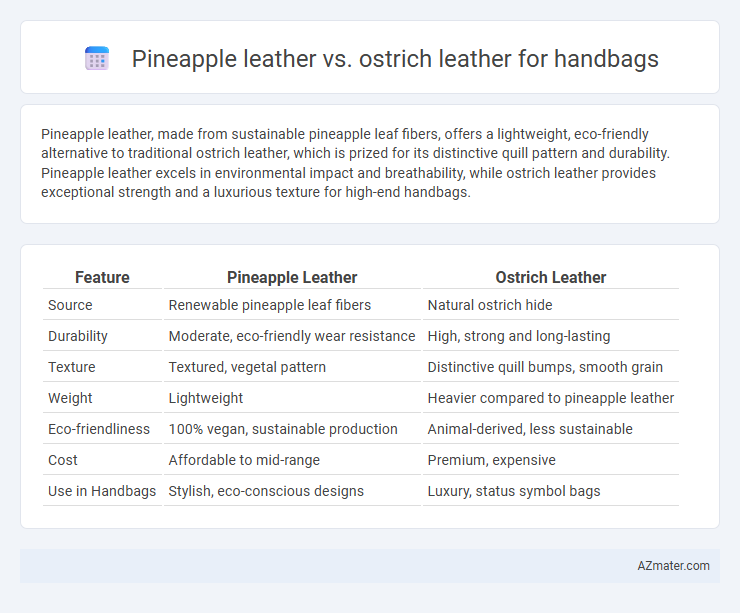Pineapple leather, made from sustainable pineapple leaf fibers, offers a lightweight, eco-friendly alternative to traditional ostrich leather, which is prized for its distinctive quill pattern and durability. Pineapple leather excels in environmental impact and breathability, while ostrich leather provides exceptional strength and a luxurious texture for high-end handbags.
Table of Comparison
| Feature | Pineapple Leather | Ostrich Leather |
|---|---|---|
| Source | Renewable pineapple leaf fibers | Natural ostrich hide |
| Durability | Moderate, eco-friendly wear resistance | High, strong and long-lasting |
| Texture | Textured, vegetal pattern | Distinctive quill bumps, smooth grain |
| Weight | Lightweight | Heavier compared to pineapple leather |
| Eco-friendliness | 100% vegan, sustainable production | Animal-derived, less sustainable |
| Cost | Affordable to mid-range | Premium, expensive |
| Use in Handbags | Stylish, eco-conscious designs | Luxury, status symbol bags |
Introduction: Comparing Pineapple Leather and Ostrich Leather for Handbags
Pineapple leather, derived from pineapple leaf fibers, offers a sustainable, cruelty-free alternative to traditional animal-based materials like ostrich leather, known for its distinctive texture and durability. Ostrich leather features a unique quill follicle pattern and exceptional strength, making it a luxurious choice for high-end handbags. Pineapple leather provides an eco-friendly option with a smooth finish and flexibility, appealing to consumers seeking ethical fashion without compromising style and quality.
Sustainability: Eco-Friendliness of Pineapple vs Ostrich Leather
Pineapple leather, made from pineapple leaf fibers, offers a highly sustainable alternative to traditional animal leathers by utilizing agricultural waste and reducing environmental impact through lower water and chemical usage. Ostrich leather, while durable and luxurious, involves ethical concerns and higher carbon footprint linked to livestock farming, including land use and greenhouse gas emissions. Choosing pineapple leather for handbags promotes eco-friendliness through renewable resources and biodegradable materials, making it a preferable option for sustainable fashion.
Durability and Longevity: Which Leather Lasts Longer?
Ostrich leather is renowned for its exceptional durability, characterized by natural quill patterns and high-fat content that resists cracking and wear, making it ideal for long-lasting handbags. Pineapple leather, crafted from pineapple leaf fibers, offers eco-friendly appeal but generally lacks the robustness and resilience of traditional animal leathers, resulting in shorter longevity under frequent use. For handbags requiring maximum durability and extended lifespan, ostrich leather remains the superior choice due to its proven strength and resistance to environmental factors.
Texture and Appearance: Visual Appeal in Handbag Design
Pineapple leather features a subtle, fibrous texture that offers a unique, eco-friendly aesthetic with a matte finish, appealing to consumers seeking sustainable luxury. Ostrich leather showcases a distinctive pattern of raised quill follicles, providing a rich, tactile surface with natural gloss that exudes classic sophistication. The contrasting textures influence handbag design by offering diverse visual depth--pineapple leather emphasizes modern, organic appeal, while ostrich leather delivers timeless elegance.
Comfort and Weight: User Experience Considerations
Pineapple leather offers a lightweight and breathable texture, enhancing comfort during extended wear compared to the denser, heavier ostrich leather. Ostrich leather's natural quill bumps provide unique aesthetics but contribute to increased weight, potentially causing fatigue with prolonged use. Users seeking a balance between comfort and style often prefer pineapple leather for handbags due to its supple feel and reduced carrying strain.
Maintenance and Care Requirements
Pineapple leather requires gentle cleaning with a damp cloth and should be kept away from direct sunlight and excessive moisture to maintain its durability and vibrant appearance. Ostrich leather needs regular conditioning with specialized leather products to prevent drying and cracking, and it is important to store handbags in a cool, dry place to preserve the distinctive quill texture. Both materials benefit from careful handling, but pineapple leather offers a more sustainable and low-maintenance alternative compared to the high-maintenance care needed for ostrich leather.
Cost Comparison: Price Differences Explained
Pineapple leather, also known as Pinatex, typically costs 30-50% less than genuine ostrich leather due to its sustainable plant-based production process and lower material expenses. Ostrich leather is priced at a premium, often ranging from $200 to $400 per square foot, driven by its rarity, durability, and unique textured appearance. The cost difference reflects not only material sourcing and processing but also market demand and exclusivity associated with each leather type for luxury handbags.
Ethical and Animal Welfare Impacts
Pineapple leather, made from the fibrous leaves of pineapple plants, offers a sustainable and cruelty-free alternative to traditional leather by utilizing agricultural waste without involving animal harm. Ostrich leather, derived from the skin of ostriches, raises ethical concerns regarding animal welfare due to farming practices and the treatment of birds during harvesting. Choosing pineapple leather reduces environmental impact while supporting animal rights, making it a more ethical option for handbag production compared to ostrich leather.
Popular Brands Using Pineapple and Ostrich Leather
Popular brands utilizing pineapple leather include Pinatex, known for eco-friendly handbags embraced by Stella McCartney and Hugo Boss, promoting sustainable fashion alternatives. In contrast, ostrich leather is favored by luxury labels such as Hermes and Prada, prized for its distinctive quill pattern and durability in high-end, long-lasting handbags. Both materials offer unique aesthetics and values, with pineapple leather highlighting environmental consciousness and ostrich leather emphasizing traditional luxury craftsmanship.
Conclusion: Choosing the Best Leather for Your Handbag
Pineapple leather offers a sustainable, cruelty-free alternative with a lightweight texture and eco-friendly appeal, making it ideal for eco-conscious consumers. Ostrich leather, prized for its durability, unique quill pattern, and luxurious feel, provides long-lasting elegance and a premium status symbol. Selecting the best leather for your handbag depends on prioritizing sustainability and ethical practices versus traditional luxury and durability.

Infographic: Pineapple leather vs Ostrich leather for Handbag
 azmater.com
azmater.com